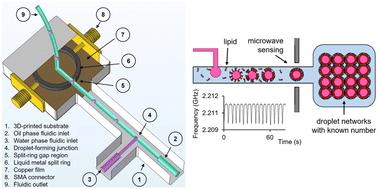Our official English website, www.x-mol.net, welcomes your
feedback! (Note: you will need to create a separate account there.)
3D-printed microfluidic–microwave device for droplet network formation and characterisation
Lab on a Chip ( IF 6.1 ) Pub Date : 2024-09-16 , DOI: 10.1039/d4lc00387j Kai Silver, Jin Li, Adrian Porch, William David Jamieson, Oliver Castell, Pantelitsa Dimitriou, Colin Kallnik, David Barrow
Lab on a Chip ( IF 6.1 ) Pub Date : 2024-09-16 , DOI: 10.1039/d4lc00387j Kai Silver, Jin Li, Adrian Porch, William David Jamieson, Oliver Castell, Pantelitsa Dimitriou, Colin Kallnik, David Barrow

|
Microfluidic–microwave devices (MMDs) have emerged as precision tools for the rapid, accurate, sensitive, and non-invasive characterisation of liquids in low-volumes. However, the fabrication of MMDs remains a significant challenge. This is due to the complexities associated with integrating fluidic ducts and electronic components. Herein, we present a versatile and economical 3D-printing approach using ducts filled with liquid metal as an electrical conductor. Cyclic olefin copolymer, polylactic acid, and polypropylene were identified as printable dielectric materials for MMD fabrication. Substrates of 3D-printed cyclic olefin copolymer exhibited the lowest loss tangent (0.002 at 2.7 GHz), making them suitable materials for high-frequency microwave devices. Liquid metal, specifically gallium–indium eutectic, was injected into the printed ducts to form electrically conductive microwave structures. Exemplary MMDs operating at 2 GHz integrated split-ring microwave resonators that serve as sensitive detection geometries able to measure changes in dielectric properties, with droplet-forming fluidic junctions and flow channels. The performance of 3D-printed MMDs for microwave droplet sensing was comprehensively evaluated. These devices were used in the formation and characterisation of water-in-oil emulsions, constructing definable lipid-segregated droplet interface bilayer (DIB) networks. This work indicates the feasibility of using 3D-printed manifolds for the rapid prototyping of customised MMDs, and also demonstrates the potential of MMDs as new analytical research tools in droplet-based materials and biochemistry studies.
中文翻译:

用于液滴网络形成和表征的 3D 打印微流体-微波装置
微流体-微波器件 (MMD) 已成为快速、准确、灵敏和非侵入性表征小体积液体的精密工具。然而,MMD 的制造仍然是一个重大挑战。这是由于与集成流体管道和电子元件相关的复杂性。在本文中,我们提出了一种多功能且经济的 3D 打印方法,该方法使用充满液态金属的管道作为电导体。环烯烃共聚物、聚乳酸和聚丙烯被确定为用于 MMD 制造的可打印介电材料。3D 打印的环烯烃共聚物的衬底表现出最低的损耗角正切(2.7 GHz 时为 0.002),使其成为高频微波器件的合适材料。液态金属,特别是镓-铟共晶,被注入打印的管道中以形成导电微波结构。在 2 GHz 下运行的示例性 MMD 集成裂环微波谐振器,用作灵敏的探测几何结构,能够测量介电特性的变化,具有液滴形成的流体结和流道。对 3D 打印 MMD 用于微波液滴传感的性能进行了全面评估。这些装置用于油包水乳液的形成和表征,构建可定义的脂质分离液滴界面双层 (DIB) 网络。这项工作表明了使用 3D 打印歧管进行定制 MMD 快速原型制造的可行性,也证明了 MMD 作为基于液滴的材料和生物化学研究中新的分析研究工具的潜力。
更新日期:2024-09-16
中文翻译:

用于液滴网络形成和表征的 3D 打印微流体-微波装置
微流体-微波器件 (MMD) 已成为快速、准确、灵敏和非侵入性表征小体积液体的精密工具。然而,MMD 的制造仍然是一个重大挑战。这是由于与集成流体管道和电子元件相关的复杂性。在本文中,我们提出了一种多功能且经济的 3D 打印方法,该方法使用充满液态金属的管道作为电导体。环烯烃共聚物、聚乳酸和聚丙烯被确定为用于 MMD 制造的可打印介电材料。3D 打印的环烯烃共聚物的衬底表现出最低的损耗角正切(2.7 GHz 时为 0.002),使其成为高频微波器件的合适材料。液态金属,特别是镓-铟共晶,被注入打印的管道中以形成导电微波结构。在 2 GHz 下运行的示例性 MMD 集成裂环微波谐振器,用作灵敏的探测几何结构,能够测量介电特性的变化,具有液滴形成的流体结和流道。对 3D 打印 MMD 用于微波液滴传感的性能进行了全面评估。这些装置用于油包水乳液的形成和表征,构建可定义的脂质分离液滴界面双层 (DIB) 网络。这项工作表明了使用 3D 打印歧管进行定制 MMD 快速原型制造的可行性,也证明了 MMD 作为基于液滴的材料和生物化学研究中新的分析研究工具的潜力。


















































 京公网安备 11010802027423号
京公网安备 11010802027423号